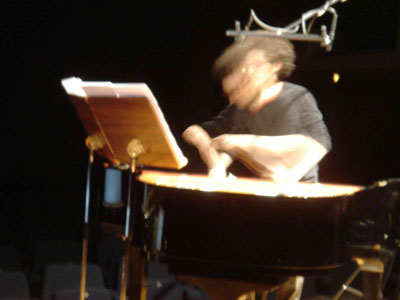COMPOSES
Étude intérieure #1 :11'
- duration:11'
- year:2004
- instrumentation:piano and marbles
- Recording: Sub Rosa portrait cd "Fremdkörper"
- full score (updated 19-9-2008)
Program notes
This composition was composed for the occasion of the concert-series “dedonderdagen” at the international arts centre “deSingel”, Antwerp. For this concert series, the ensemble for contemporary and experimental music “Champ d’Action” set up the project “Looking for the borders” in which the borders between improvised music and composed music were investigated. To do this investigation, I was invited together with the “collectief reFLEXible”, a free-improvisers quartet in which I play, to perform together with members of the ensemble Champ d’Action and Austrian composer-performer Karhleinz Essl.
It was partly thanks to the free improvised music that I started to compose again as an eightteen-year-old, something I stopped doing since i was an adolescent. The direct contact with the “sound-material” which led to my fascination for the “inside of the sound”, something typically connected with improvising music, was probably the catalyst for my renewed interest in composing. Soon after this, I started to use the piano as a huge resonator, in which the use of the keys to make sounds was only one possibility. Placing objects on the strings and/or playing the strings directly, created a whole new and huge universe of sounds.

In the compositions I wrote since that the time, parrallel to my activities as an improviser, I tried to give this “hedonistic” way of making music an important part and I tried to incorporate in the score aspects of the freedom one experiences when improvising. This search can already be traced back until No habra una sola cosa que no sea una nube, a quintet for piano and woodwinds that I composed for Champ d’Action. In the final part of this quintet, I used marbles in the inside of the piano, directly on the strings. Already when composing this piece, I was fascinated by the vast sound-possibilities of this way of soundproduction, and decided to write a piece for piano solo using only marbles, directly on the strings. This gave me the possibility to go one step further in my search for the “emancipation of the sound”. From this idea, the Etude Interieure #1 has been born.
In this composition the keys of the piano we’re not used at all: the complete production of the sound happens INSIDE the piano, directly on the strings, using marbles. Absolute pitch was replaced in the notation by relative pitch. Durations (on micro-level) are relatively flexible, ryhthm and gesticulation were seen as commutable parameters: sometimes the rhythm was translated to gesticulation, sometimes the gesticulation was put into rhythmical patterns.
The composition therefore has a very important visual and theatrical aspect: the movements of the performer made when manipulating the strings with the marbles, form a complete choreography (which is impossible to perceive in recordings). And this brings me back to my experiences as an improvisig musician. Improvisations always have a very physical, almost dionysian aspact that the performing of traditional, written music often lacks.
In the etude Intérieure #1, this tactile and theatrical aspect is of great importance. Or to use the words of Richard Barrett: “Music as a theatre of action”.